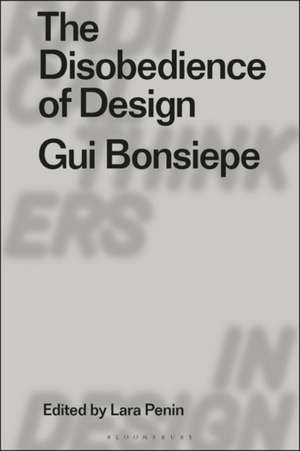The Disobedience of Design: Gui Bonsiepe: Radical Thinkers in Design
Autor Lara Peninen Limba Engleză Hardback – 29 dec 2021
| Toate formatele și edițiile | Preț | Express |
|---|---|---|
| Paperback (1) | 174.99 lei 3-5 săpt. | +44.86 lei 4-10 zile |
| Bloomsbury Publishing – 29 dec 2021 | 174.99 lei 3-5 săpt. | +44.86 lei 4-10 zile |
| Hardback (1) | 505.95 lei 3-5 săpt. | +59.80 lei 4-10 zile |
| Bloomsbury Publishing – 29 dec 2021 | 505.95 lei 3-5 săpt. | +59.80 lei 4-10 zile |
Preț: 505.95 lei
Preț vechi: 619.38 lei
-18% Nou
Puncte Express: 759
Preț estimativ în valută:
96.84€ • 105.23$ • 81.40£
96.84€ • 105.23$ • 81.40£
Carte disponibilă
Livrare economică 31 martie-14 aprilie
Livrare express 14-20 martie pentru 69.79 lei
Preluare comenzi: 021 569.72.76
Specificații
ISBN-13: 9781350162457
ISBN-10: 1350162450
Pagini: 480
Ilustrații: 24 bw illus, 15 colour illus
Dimensiuni: 156 x 234 x 25 mm
Greutate: 0.93 kg
Editura: Bloomsbury Publishing
Colecția Bloomsbury Visual Arts
Seria Radical Thinkers in Design
Locul publicării:London, United Kingdom
ISBN-10: 1350162450
Pagini: 480
Ilustrații: 24 bw illus, 15 colour illus
Dimensiuni: 156 x 234 x 25 mm
Greutate: 0.93 kg
Editura: Bloomsbury Publishing
Colecția Bloomsbury Visual Arts
Seria Radical Thinkers in Design
Locul publicării:London, United Kingdom
Caracteristici
Responds
to
market
demand
for
more
non-Western
coverage
and
perspectives
and
more
primary
source
material
in
our
print
and
digital
publishing
Notă biografică
Gui
Bonsiepestudied
information
design
at
the
hfg
ulm
(Hochschule
für
Gestaltung
Ulm),
Germany
from
1955-1959,
where
he
taught
as
Assistant
Professor
from
1960-1968.
Since
1968
he
has
been
a
designer
and
consultant
for
industrialization
policy
in
Chile,
Argentina,
and
Brazil.
From
1993-2003
he
was
Professor
of
Interface
Design
at
the
University
of
Applied
Sciences,
Cologne,
Germany.
He
lives
and
works
in
Brazil
and
Argentina.Lara
Peninis
Associate
Professor
of
Transdisciplinary
Design
at
Parsons
School
of
Design,
USA.
Author
ofAn
Introduction
to
Service
Design:
Designing
the
Invisible(Bloomsbury,
2018),
her
work
is
at
the
intersection
of
service
and
strategic
design,
participatory
design
and
social
justice.
She
is
a
graduate
in
Architecture
and
Urbanism
from
the
University
of
São
Paulo,
Brazil,
and
has
a
PhD
in
Design
from
Milan
Polytechnic
University,
Italy.
Cuprins
Introduction
by
Lara
PeninNotes
on
the
Making
of
the
BookRecognition
and
Acknowledgements
by
Gui
BonsiepeEditorial
AcknowledgementsPart
1:
Thinking
DesigningIntroduction
to
Part
1
by
Frederico
Duarte(a)
Essays
on
ulm1.1
The
Cartography
of
Modernity1.2
Science
and
Design1.3
The
Relevance
of
the
Ulm
School
of
Design
today1.4
The
Invisible
Aspects
of
the
HfG
Ulm(b)
Theory
and
Practice1.5
The
Discomfort
of
Design
Theory1.6
Arabesques
of
Rationality:
Or
the
Splendor
and
Boredom
of
Design
Methodology1.7
The
Uneasy
Relationship
of
Design
and
Design
Research(c)
Design,
Politics,
Ethics1.8
Design,
Nomadism
and
Politics:
Interview
with
Alejandro
Lazo
Margain1.9
Design
and
Democracy1.10
Some
Virtues
of
DesignPart
II:
Design
in
the
"Periphery"Introduction
to
Part
II
by
Ethel
Leon(a)
From
Europe
to
South
America2.1
Peripheral
Vision
&
Design
Empowerment:
Interview
with
James
Fathers2.2
Industrial
Design
in
Chile
1971-1973:
Interview
with
Hugo
Palmarola2.3
The
Ulm
Model
in
the
Periphery2.4
Industrialization
Without
Design(b)
Design
in
the
"Periphery"2.5
History
of
Design
in
Latin
America2.6
Aspects
of
Design
in
the
Periphery2.7
Between
Favela
Chic
and
Autonomy:
Design
in
Latin
America(c)
The
Question
of
Difference2.8
Between
Marasmus
and
Hope2.9
The
Environment
in
the
North-South
Conflict2.10
Identity
and
Counter-Identity
of
DesignPart
III:
Design,
Visuality,
CognitionIntroduction
to
Part
III
by
Hugh
Dubberly(a)
Design
and
Language3.1
Through
Language
to
Design3.2
Design:
from
Material
to
Digital
and
Back3.3
Design
as
Tool
for
Cognitive
Metabolism:
From
Knowledge
Production
to
Knowledge
Presentation(b)
Design/
Visuality/
Theory3.4
Visual/Verbal
Rhetoric3.5
The
Interface
Design
of
Computer
Programs3.6
Designing
Information3.7
Visuality
|
Discursivity,
or
Design:
The
Blind
spot
of
Theory,
Theory:
the
Blind
spot
of
Design(c)
Design
and
Crisis3.8
Design
and
Crisis3.9
Convergences
/
Divergences
-
Hannes
Meyer
and
the
HfG
Ulm3.10
The
Disobedience
of
DesignPart
IV:
Design
and
Development
/
ProjectsIntroduction
to
Part
IV
by
Constantin
Boym(a)
Design
Policy/Design
and
Development4.1
Development
Through
Design,
a
Report
for
UNIDO,
19734.2
Design
and
Development:
The
Debate
with
Victor
Papaneka.
Gui
Bonsiepe:
Review
of
Design
for
the
Real
World
by
Victor
Papanekb.
Victor
Papanek:
Reply
to
Bonsiepe's
Review4.3
Design
and
Development
40
Years
Later:
Interview
with
Gabriel
Patrocínio
and
José
Mauro
Nunes(b)
Gui
Bonsiepe:
Selected
Projects
in
Latin
America4.4
Inexpensive
Record
Player,
Chile,
19724.5
Nutrition
project:
Spoon
for
Powdered
Milk,
Chile
19734.6
Agriculture
project,
Chopper,
Chile,
19734.7
Consumer
product:
Air-conditioning,
Argentina,
19804.8
Two
projects
for
Local
Industry
in
Brazil,
1984-864.9
Health
Care
Project:
Needle
for
Blood
Sampling,
Brazil,
1986(c)
Case
Study
of
Project
Cybersyn,
Chile4.10
(a)
Opsroom:
Interface
of
a
Cybernetic
Management
Room4.10
(b)
'Socialism
by
Design'
by
Eden
MedinaAfterword
by
Zoy
Anastassakis
&
Marcos
MartinsAppendices:
Three
Notes
on
the
Closure
of
ulm
(1968)1.
The
Situation
of
the
HfG2.
Communication
&
Power:
A
Marginal
Note3.
Resolution
of
the
Hochschule
für
Gestaltung,
Ulm
Gui
Bonsiepe:
A
Brief
BiographyContributorsIndex
Recenzii
Wielding
a
powerful
dissenting
design
imagination,
Gui
Bonsiepe
is
one
of
the
most
complex
and
accomplished
design
thinkers
of
our
time.
As
this
judiciously
organized
collection
of
his
writings
and
projects
demonstrates,
beginning
with
his
work
in
Ulm
in
the
1960s
and
then
in
Latin
America
after
1970,
and
continuing
through
to
his
pioneering
development
of
ontological
interface
design
in
the
1990s
through
to
his
more
recent
critiques
of
"design
thinking",The
Disobedience
of
Designoffers
perspectives
that
challenge,
radically,
the
limitations
of
contemporary
European
and
American
design
practice
and
theory.






